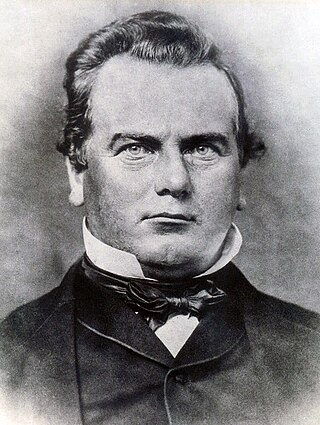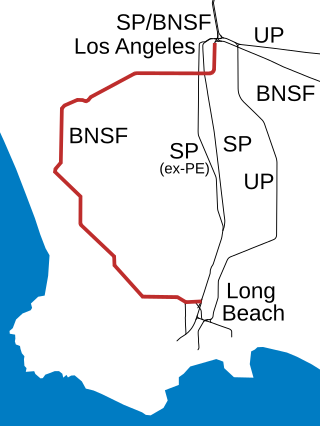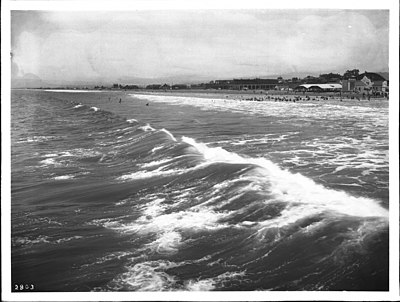
The South Bay is a region of the Los Angeles metropolitan area, located in the southwest corner of Los Angeles County. The name stems from its geographic location stretching along the southern shore of Santa Monica Bay. The South Bay contains sixteen cities plus portions of the City of Los Angeles and unincorporated portions of the county. The area is bounded by the Pacific Ocean on the south and west and generally by the City of Los Angeles on the north and east.

San Pedro is a neighborhood located within the South Bay and Harbor region of the City of Los Angeles, California, United States. Formerly a separate city, it consolidated with Los Angeles in 1909. The Port of Los Angeles, a major international seaport, is partially located within San Pedro. The district has grown from being dominated by the fishing industry, to a working-class community within the city of Los Angeles, to an increasingly dense community.

Wilmington is a neighborhood in the South Bay and Harbor region of Los Angeles, California, covering 9.14 square miles (23.7 km2).

The Port of Los Angeles is a seaport managed by the Los Angeles Harbor Department, a unit of the City of Los Angeles. It occupies 7,500 acres (3,000 ha) of land and water with 43 miles (69 km) of waterfront and adjoins the separate Port of Long Beach. Promoted as "America's Port", the port is located in San Pedro Bay in the San Pedro and Wilmington neighborhoods of Los Angeles, approximately 20 miles (32 km) south of downtown.

Terminal Island, historically known as Isla Raza de Buena Gente, is a largely artificial island located in Los Angeles County, California, between the neighborhoods of Wilmington and San Pedro in the city of Los Angeles, and the city of Long Beach. Terminal Island is roughly split between the Port of Los Angeles and Port of Long Beach. Land use on the island is entirely industrial and port-related except for Federal Correctional Institution, Terminal Island.

The Wilmington Oil Field is a prolific petroleum field in Los Angeles County in southern California in the United States. Discovered in 1932, it is the third largest oil field in the United States in terms of cumulative oil production. The field runs roughly southeast to northwest through the Los Angeles Basin, stretching from the middle of San Pedro Bay through Long Beach and east of the Palos Verdes Peninsula. The field originally contained approximately 3 billion barrels (480,000,000 m3) of reserves. In 2013, the USGS estimated future potential production from the combined Wilmington-Belmont oilfield could be around 900 million barrels (140,000,000 m3).
The Free Harbor Fight refers to the legal battle in the late nineteenth century on the West Coast of the United States, around Los Angeles Area Chamber of Commerce against Huntington and the Southern Pacific. US Senator Stephen M. White failed to cave in to the pressure of the railroad baron Collis Huntington and his congressional allies, which resulted in the Port of Los Angeles being located in San Pedro, instead of Santa Monica, as Huntington had wanted.

Phineas Banning was an American businessman, financier and entrepreneur.

The Port of Long Beach, administered as the Harbor Department of the City of Long Beach, is a container port in the United States, which adjoins Port of Los Angeles. Acting as a major gateway for US–Asian trade, the port occupies 3,200 acres (13 km2) of land with 25 miles (40 km) of waterfront in the city of Long Beach, California. The Port of Long Beach is located less than two miles (3 km) southwest of Downtown Long Beach and approximately 25 miles (40 km) south of Downtown Los Angeles. The seaport generates approximately US$100 billion per year in trade and employs more than 316,000 people in Southern California. In 2022, the port, together with the adjoining Port of Los Angeles, were considered amongst the world's least efficient ports by the World Bank and IHS Markit citing union protectionism and a lack of automation.

The Harbor Subdivision is a single-track main line of the BNSF Railway which stretches 26 miles (42 km) between rail yards near downtown Los Angeles and the ports of Los Angeles and Long Beach across southwestern Los Angeles County. It was the primary link between two of the world's busiest harbors and the national rail network. Mostly displaced with the April 15, 2002 opening of the more direct Alameda Corridor, the Harbor Sub takes a far more circuitous route from origin to destination, owing to its growth in segments over the decades. The subdivision was built in this fashion beginning in the early 1880s to serve the ports and the various businesses that developed along it.

State Route 47 is a state highway in the U.S. state of California, connecting Terminal Island to the mainland in the Los Angeles area. From its south end at I-110 in San Pedro, it heads east across the Vincent Thomas Bridge to the island and the end of state maintenance. The state highway begins again at the junction with I-710 on Terminal Island, crossing the Schuyler Heim Bridge north to the mainland and the second terminus, where SR 103 begins. Signage continues along a locally maintained route, mainly Alameda Street, to the Gardena Freeway in Compton, and an unconstructed alignment follows the same corridor to the Santa Monica Freeway (I-10) near downtown Los Angeles.

The Commodore Schuyler F. Heim Bridge was a vertical-lift bridge in the Port of Los Angeles. Dedicated on January 10, 1948, the bridge allowed State Route 47 to cross over the Cerritos Channel. Named after Schuyler F. Heim, who was in command of the Naval Air Station on Terminal Island in 1942, the bridge was one of the largest vertical-lift bridges on the West Coast. At the time of its opening, it was the highest in the country with the deck weighing about 820 short tons. Its towers are 186 feet (57 m) tall above the roadway deck and about 236 feet (72 m) tall when measured from the water level at high water. The bridge was decommissioned on October 12, 2015 and replaced by a new, six-lane fixed-span bridge in order to meet current safety and earthquake standards. A replacement bridge, tentatively titled State Route 47 Schuyler Heim Bridge Replacement, was completed in September 2020.

Cabrillo Beach is a historic public beach located in San Pedro, Los Angeles, California. It is named after Juan Rodríguez Cabrillo, a Spanish explorer who was the first to sail up the California coast. Cabrillo has two separate beach areas.

Harbor City is a highly diverse neighborhood in the South Bay and Harbor region of Los Angeles, California, with a population upward of 36,000 people. Originally part of the Rancho San Pedro Spanish land grant, the 2.58-square-mile (6.7 km2) Harbor City was brought into Los Angeles as a preliminary step in the larger city's consolidation with the port cities of Wilmington and San Pedro.

The THUMS Islands are a set of four artificial islands in San Pedro Bay off the coast of Long Beach, California. The THUMS Islands were built in 1965 to tap into the East Wilmington Oil Field. The landscaping and sound walls were designed to camouflage the operation and reduce noise, and they are the only decorated oil islands in the United States. The islands were named for the company who bid for original operating contract, THUMS, a consortium named after its parent companies: Texaco, Humble, Unocal, Mobil, and Shell.

The Los Angeles Harbor Region is in Los Angeles County, California. The area is impacted by the harbor complex consisting of the Port of Los Angeles and the Port of Long Beach.

The Long Wharf in Santa Monica, also known as Port Los Angeles or the Mile Long Pier, was an extensive pier wharf constructed by the Southern Pacific Railroad Company in Santa Monica Bay from 1892 to 1894. When it opened in 1894, it was the longest wharf in the world, measuring approximately 4,700 feet (1,400 m). It served as a cargo and passenger port until 1913, and in 1919 removal of the wharf started. The wharf, the 1,000 foot (300 m) tip of the pier, was removed by 1920. The remaining 3,600 feet (1,100 m) of pier was used as a run down fishing pier until 1933, when the remainder of the pier was removed. One of the major imports to the wharf was lumber from Northern ports, to help in the construction boom in Southern California. Southern Pacific Railroad and the street cars of the Los Angeles Pacific Railroad served the wharf. Los Angeles Pacific Railroad ran passenger trams to the wharf and from midnight to sunrise ran cargo cars.

The Los Angeles & San Pedro Railroad was Southern California's first railroad. Its 21-mile (34 km) line from San Pedro Bay to Los Angeles was built from 1868 to 1869 and began operations on October 26, 1869. The railroad was the brainchild of Phineas Banning and its primary purpose was to transport freight from the port to the city.

Naval Operating Base Terminal Island, was United States Navy base founded on 25 September 1941 to support the World War II efforts in the Pacific War. Naval Operating Base Terminal Island was founded by combining Naval Facilities in cities of San Pedro, Long Beach and Wilmington, California under one command. Much of the base was on the man-made Terminal Island, and harbor in San Pedro Bay. The harbor was made through the construction of a large breakwater system.

Naval Base San Pedro and San Pedro Submarine Base were United States Navy bases at the Port of San Pedro, California officially founded in 1919. While commissioned in 1919, the Navy started operating out of the port in 1910, by renting dock space at the City of San Pedro's Dock No. 1 in 1914. The Navy had vessels stationed at the port starting in 1913. The San Pedro Submarine Base closed in 1923, with the end of World War I. Naval Base San Pedro became part of Naval Operating Base Terminal Island on 25 September 1941, which closed in 1947.























